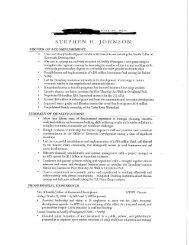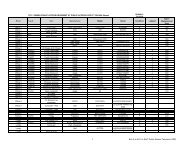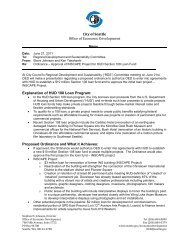2013 Water System Plan, Volume II - Seattle City Clerk's Office - City ...
2013 Water System Plan, Volume II - Seattle City Clerk's Office - City ...
2013 Water System Plan, Volume II - Seattle City Clerk's Office - City ...
You also want an ePaper? Increase the reach of your titles
YUMPU automatically turns print PDFs into web optimized ePapers that Google loves.
5.9.3 Hydraulic Mixing for <strong>Water</strong> Age and <strong>Water</strong><br />
Quality Control<br />
To prevent hydraulic dead zones and excessive water ages within a storage tank or reservoir,<br />
there must be a means for complete hydraulic mixing throughout the entire volume of the<br />
storage cell. The configuration and sizes of inlet and outlet pipes to the cell have a direct impact<br />
on the degree of hydraulic mixing achievable.<br />
Each storage cell should have a volume in which water age (hydraulic detention time) is not<br />
more than 5 days at projected average water demands when the reservoir operates at full<br />
capacity. The goal is to keep total water age through the reservoir to no more than a 5-to-7-day<br />
range.<br />
The <strong>Water</strong> Research Foundation publication, Maintaining <strong>Water</strong> Quality in Finished <strong>Water</strong><br />
Storage Facilities, describes design considerations and features for controlling water quality in<br />
storage facilities.<br />
5.9.3.1 Inlet and Outlet Pipes<br />
Generally, a separation of the inlet and outlet points within a storage cell will enhance mixing<br />
and help avoid water quality problems associated with dead zones and short circuiting. For<br />
ground tanks, this is done by locating the inlet discharge near the perimeter of the cell with an<br />
upward bend. The tank outlets are then placed into the center of the tank floor. In elevated<br />
tanks, inlet an outlet points are separated one of two ways:<br />
Bring separate inlet and outlet lines up through the tank<br />
Split the line in the riser and use check valves to introduce water into the center of<br />
the tank near the top of the water column. In this option, the outlet pipes are placed<br />
at the tank perimeter with a vertical separation to the inlet elevation of not less than<br />
about ½ the total cell height.<br />
Proprietary pipe and valve systems for storage facilities can be specifically designed based on<br />
the momentum mixing principle. The Red Valve Company system has gained widespread use.<br />
For smaller tanks (less than 0.5 million gallons), the inlet and outlet may not need to be<br />
separated. Smaller tanks have smaller volumes, which allow adequate momentum for mixing.<br />
A. Inlet Pipe<br />
The inlet pipe should be as small as practicable to maximize inlet velocity to provide for<br />
adequate momentum mixing throughout the storage cell to preclude hydraulic shortcircuiting.<br />
Reductions of inlet diameter have also been retrofitted on existing SPU tanks<br />
during tank renovation by using a reducer on the discharge end of the inlet pipe.<br />
B. Outlet Pipe<br />
In ground level reservoirs, each storage cell should have two outlet pipes, one near the<br />
mid-level and the other near the bottom of the cell. Both outlets should have isolation<br />
valves. The mid-level and lower outlets remain open for normal operation. The lower<br />
outlet should have a seismic valve that closes automatically during an earthquake to<br />
prevent the cell from draining past the mid-level.<br />
5-54 SPU Design Standards and Guidelines
















